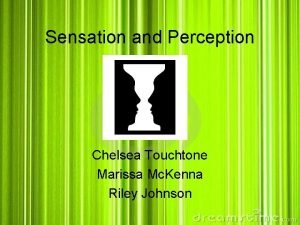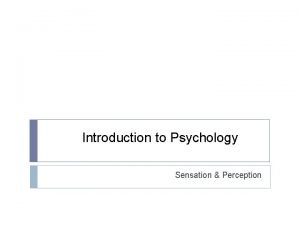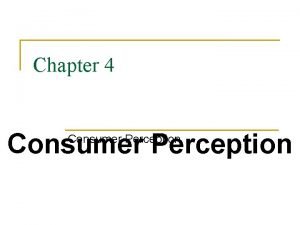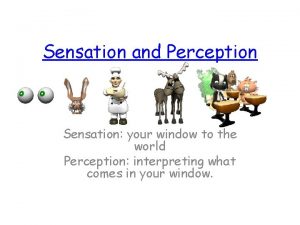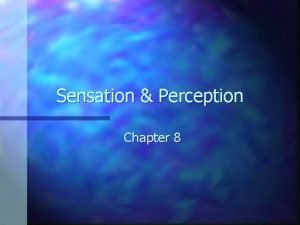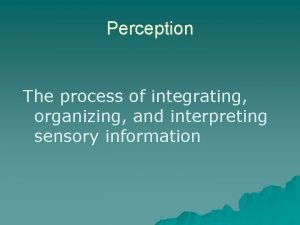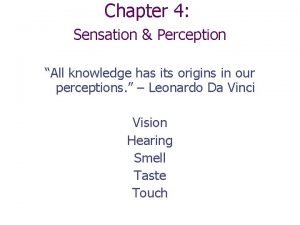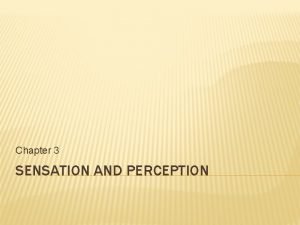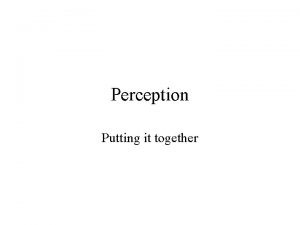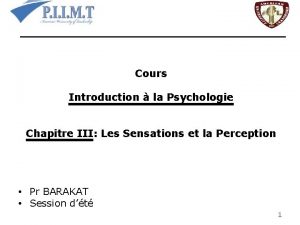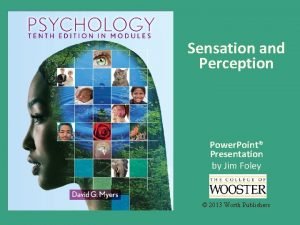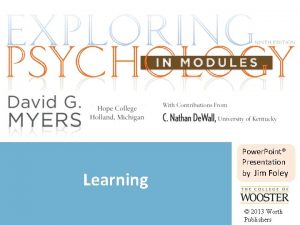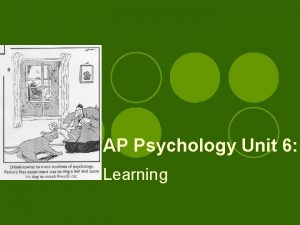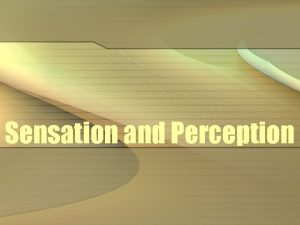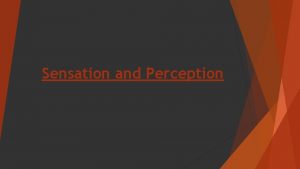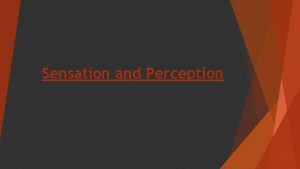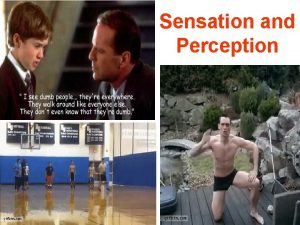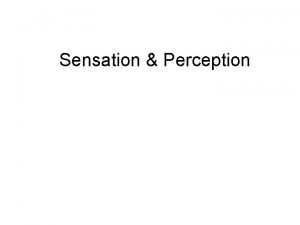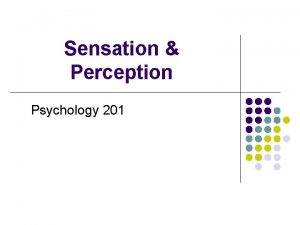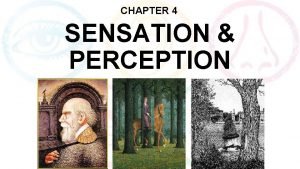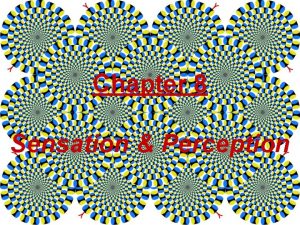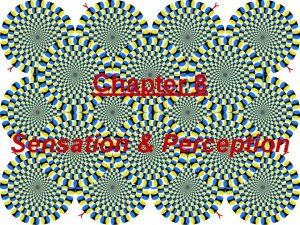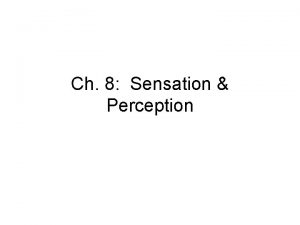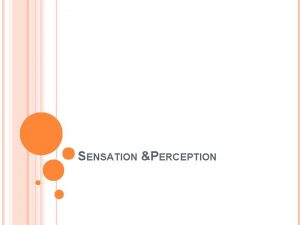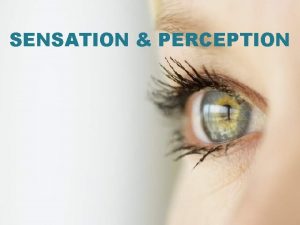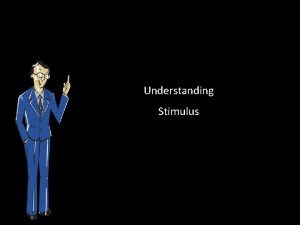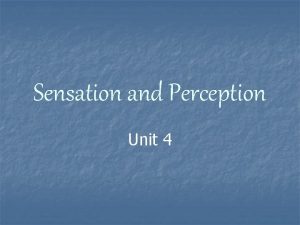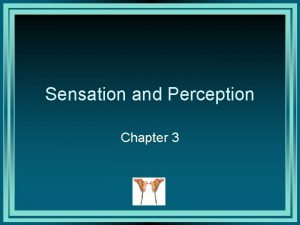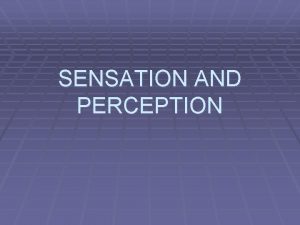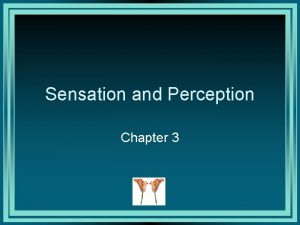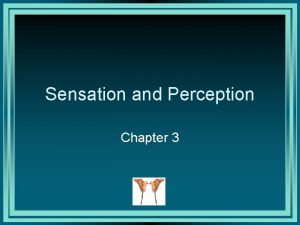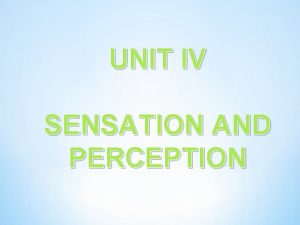Sensation and Perception ENG110 Stimulus Stimulus refers to






















- Slides: 22

Sensation and Perception ENG-110

Stimulus • Stimulus refers to energy that produces a response in a sense organ.

Sensation • Sensation refers to activation/stimulation of sense organ (physical response). OR • The process of detecting, receiving, converting and transmitting information resulting from stimulation of sensory receptors.

Perception • Perception refers to selection, interpretation and organization of sensory input. OR • Basically perception involves interpretation/translation of stimulus into something meaningful (psychological response).

• The basic function of sensation is detectionof sensory stimuli, whereas perception generally involves interpretation of the same stimuli. • Our senses tell us something is out there. Our perception tell us what that something is.

The human senses • Vision(sense of sight) sensitive to LIGHT ENERGY • Auditory (sense of hearing) stimulated by SOUND ENERGY • Olfaction (sense of smell) stimulates our nostrils by CHEMICAL ENERGY • Gustation (sense of taste) • Tactile (skin senses for pressure, temperature, pain) THERMAL ENERGY • Vestibular (a strong connection between sense of balance and ear) sense that is involved in body position and movement of the head. • Kinesthesia (sense of posture and movement, body, joint and muscles) • Organic (sensation from internal organs such as hunger, thirst,

Bottom up processing • Perception that consists of the progression of recognizing and processing information from individual components of a stimuli and moving to the perception of the whole. OR • Bottom-up processing, a progression from individual elements to the whole

• Example • patterns and features of each of the separate letters.

Top down processing • Perception that consists of the progression of recognizing and processing information from whole to the perception of the individual elements. OR • Top-down processing, a progression from the whole to the elements

• It is based on experience and expectations. • Example • To perceive a word before its individual letters. • q

Gestalt laws of organization • A series of principles that describe how we organize bits and pieces of information into meaningful wholes. • Closure • Proximity • Similarity • Simplicity • Figure and ground • continuity

Closure • We perceive “complete” figures that actually have gaps in them

Proximity • We perceive elements that are closer together as grouped together.

Similarity • Elements that are similar in appearance we perceive as grouped together • And we also tend to think they have the same function. • For instance, in this image, there appear to be two separate and distinct groups based on shape: the circles and the squares.

Symmetry • In organizing stimuli, we tend to favor symmetrical objects or relationships.

Figure and ground • Dividing visual displays into figure and ground is a fundamental way in which people organize visual perceptions. • The figure is the thing being looked at, and the ground is the background against which it stands.

Continuity • We perceive elements in ways that produce smooth continuation

Perceptual constancy • The phenomenon in which physical objects are perceived as unvarying and consistent despite changes in their appearance or in the physical environment. OR • Perceptual constancy leads us to view objects as having an unvarying size, shape, color, and brightness, even if the image on our retina varies.

Size constancy • Refers to our ability to see objects as maintaining the same size even when our distance from them makes things appear larger or smaller. • Example • As we walk away from radio, the song appears to get softer. We understand/perceive it as being just as loud as before.

Shape constancy • Refers to our ability to see objects as maintaining the same shape even when we see them from different angles.

• Example • Everybody has seen a plate shaped in the form of a circle. When we see that same plate from an angle, however, it looks more like an ellipse. Shape constancy allows us to perceive that plate as still being a circle even though the angle from which we view it appears to distort the shape.

Brightness constancy • Refers to our ability to recognize that color remains the same regardless of how it looks under different level of light. • Example • That deep blue shirt you wore to the beach suddenly looks black when you walk indoors.
 Chapter 5 sensation and perception
Chapter 5 sensation and perception Gestalt laws of visual perception
Gestalt laws of visual perception Perceptual set ap psych
Perceptual set ap psych What are sensations
What are sensations Sensation and perception crossword puzzle
Sensation and perception crossword puzzle Chapter 3 sensation and perception
Chapter 3 sensation and perception Sensation and perception
Sensation and perception Chapter 6 sensation and perception
Chapter 6 sensation and perception Chapter 4 sensation and perception test
Chapter 4 sensation and perception test Pecetion
Pecetion Sensation and perception
Sensation and perception Sensation and perception
Sensation and perception Kinesthetic sense
Kinesthetic sense Chapter 8 sensation and perception
Chapter 8 sensation and perception Sensation and perception uu
Sensation and perception uu Chapter 4 sensation and perception
Chapter 4 sensation and perception Chapter 3 sensation and perception
Chapter 3 sensation and perception Perception vs sensation
Perception vs sensation Exposé sur la sensation en psychologie
Exposé sur la sensation en psychologie Perception vs sensation
Perception vs sensation Face recognition
Face recognition Generalization classical conditioning
Generalization classical conditioning Unit 6 ap psychology
Unit 6 ap psychology




